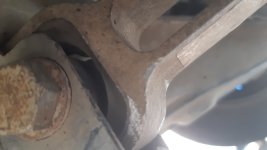Paul Jaggard
Member
After 190k miles in 17 years, finally a serious problem.
A few weeks ago, catastrophic clutch failure...required a new gearbox too.
A severe thumping, using a solid towing-bar, resulting in the towing hook tearing off the metal mounting, and plastic bumper.
Usual garage too busy, so neighbour replaced clutch and box.
Everything seemed ok, (although there was a very small thumping sound just as the engine caught)
OK for a time, then after a long hot journey, wouldn't start.
The fault has recurred sometimes since. After waiting a few hours it starts again.
I've since added a secondary earth from battery to engine, and thought that this had solved my problem
Now, usually it starts fine, but sometimes it acts as if there is only a low voltage getting to the solenoid trigger.
I've noticed that the tank fuel pump doesn't turn off after a few seconds like it should.
I've had 1 blown 20a ignition switch, fuse a week or two ago. (maybe I left the ignition switch on too long when the engine wouldn't start?)
Today, I've discovered that if I put on the interior light, then turn the ignition switch to its second position, if it dims slightly then the engine will start.
However if it dims a lot (to around 6v) and the solenoid sounds feeble, then it won't start.
I've had the starter off, and it always works fine on the bench (though I have to push the interior solenoid button with something harder than my finger to give continuity at the main contacts.
My Haynes circuit diagram takes 2 wires from the second position of the switch. One via engine compartment fusebox, and "short circuit coupling" (whatever that is), to the ECU.
And the other via passenger fusebox to Body Control Unit.
The interior light seems to get its power from the body control unit.
Why would my ignition switch give this low voltage, and will I have to dismantle the steering wheel to get at it?
Or is the problem elsewhere? ECU? BCU? Relay?
I noticed that my neighbour was much rougher manhandling the ECU cables than I would dare be, but unplugging, and reinserting them didn't help.
After 17 years virtually trouble free, it has come as a bit of a shock to have these problems all at once!
Has anyone else experienced anything similar, or have any suggestions?
A few weeks ago, catastrophic clutch failure...required a new gearbox too.
A severe thumping, using a solid towing-bar, resulting in the towing hook tearing off the metal mounting, and plastic bumper.
Usual garage too busy, so neighbour replaced clutch and box.
Everything seemed ok, (although there was a very small thumping sound just as the engine caught)
OK for a time, then after a long hot journey, wouldn't start.
The fault has recurred sometimes since. After waiting a few hours it starts again.
I've since added a secondary earth from battery to engine, and thought that this had solved my problem
Now, usually it starts fine, but sometimes it acts as if there is only a low voltage getting to the solenoid trigger.
I've noticed that the tank fuel pump doesn't turn off after a few seconds like it should.
I've had 1 blown 20a ignition switch, fuse a week or two ago. (maybe I left the ignition switch on too long when the engine wouldn't start?)
Today, I've discovered that if I put on the interior light, then turn the ignition switch to its second position, if it dims slightly then the engine will start.
However if it dims a lot (to around 6v) and the solenoid sounds feeble, then it won't start.
I've had the starter off, and it always works fine on the bench (though I have to push the interior solenoid button with something harder than my finger to give continuity at the main contacts.
My Haynes circuit diagram takes 2 wires from the second position of the switch. One via engine compartment fusebox, and "short circuit coupling" (whatever that is), to the ECU.
And the other via passenger fusebox to Body Control Unit.
The interior light seems to get its power from the body control unit.
Why would my ignition switch give this low voltage, and will I have to dismantle the steering wheel to get at it?
Or is the problem elsewhere? ECU? BCU? Relay?
I noticed that my neighbour was much rougher manhandling the ECU cables than I would dare be, but unplugging, and reinserting them didn't help.
After 17 years virtually trouble free, it has come as a bit of a shock to have these problems all at once!
Has anyone else experienced anything similar, or have any suggestions?



